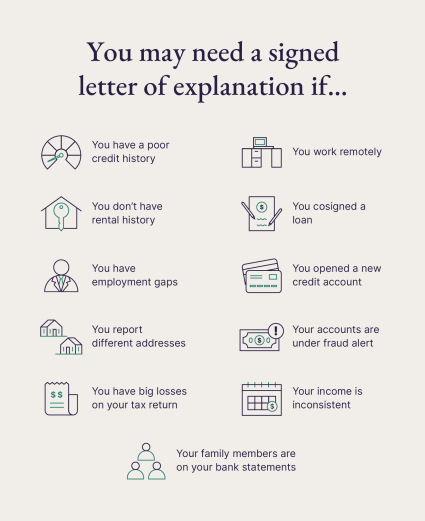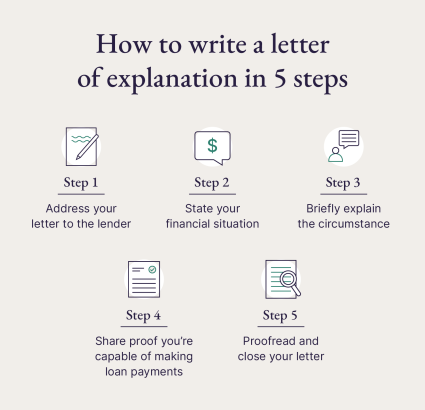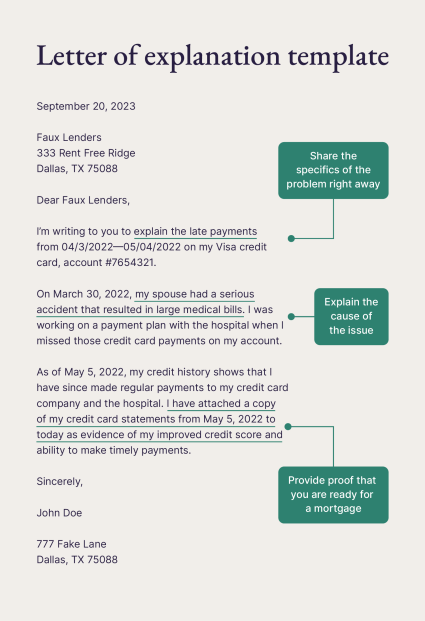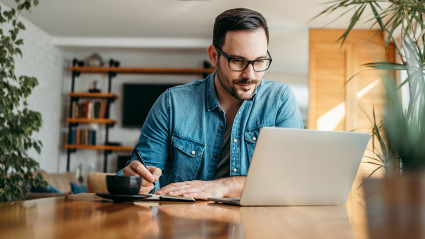What is a letter of explanation?

Fully managed second homes
Why do you need a letter of explanation?

1. You have a poor credit history
Your credit history helps lenders know how you’ve handled debt in the past. The following red flags can potentially indicate poor debt management and may require a letter of explanation:- Late payments
- Bankruptcy
- Foreclosures
2. You don’t have rental history
Ideally, lenders want to see that you have a consistent rental history for the last 12 months. This reassures them that you will be able to handle regular mortgage payments. If you have a gap in your rental history, explain the cause. Caring for a family member or recovering from an accident are possible explanations for a rental hiatus.3. You have employment gaps
Similar to your rental history, lenders prefer to see consistent employment in the year prior to your loan application. This shows the lender that you have the income to make regular mortgage payments.It’s possible for a lender to be flexible when they know more about the circumstances that led to an employment gap. Being laid off or raising children are possible explanations for the lack of recent work experience.4. You report different addresses
If the address on your driver’s license does not match the address on your loan application or credit report, a lender may ask you to explain the discrepancy.5. Your income is inconsistent
Underwriters will carefully review your income. If it fluctuates often, they may request an explanation letter. If you are self-employed, your accountant may also have to write a letter of explanation to verify how you generate your income.6. You work remotely
If your remote career is tied to an address in a city or state that is different from where you are buying a home, a lender may request that your company provide a letter of explanation verifying that your career (and income) will not be affected by your move.7. You have substantial losses on your tax return
If you are a self-employed business owner or independent contractor, it’s normal to file losses on your first few tax returns. A lender may request a letter of explanation to ensure that these losses will not be consistent and will not affect your ability to make regular mortgage payments.8. You cosigned a loan
In the event that you cosigned a loan, a lender will want an explanation letter ensuring that you are not the one making the payments. This can apply to student loans, auto loans and mortgages.9. You opened a new credit account
If you open a new credit account while applying for a mortgage loan, a lender may suspect that the debt could affect your ability to repay your loan. Remember that the underwriter will also review your finances during closing, so hold off on opening new lines of credit until the sale is complete, if possible.10. Your family members are on your bank statements
If multiple people appear on your bank statements, like parents or children, you will need to write a letter explaining that you’re in control of the funds being used to pay for your new home. Anyone who helps you with the down payment of the home will also be responsible for writing a gift letter of explanation.11. Your accounts are under fraud alert
A lender will want to know that you’re aware of any suspicious activity on your credit report. If your accounts are under fraud alert or your credit is frozen, prepare a letter of explanation that outlines how you will regain control of your finances.How to write a letter of explanation

- Your full legal name
- Your spouse's full legal name (if applying together)
- Your current mailing address
- The address of the lender
- Your phone number
- Marriage license if applicable
- Bills of sale (for large assets like a car)
- Title transfers
- Address your letter: Write the date and lender’s address at the top of the explanation letter, then address the lender or lending institution.
- State your financial situation: Be upfront about your financial issues. Your application already indicates something suspicious to your lender, so there’s no need to hide the truth. Quickly state the fact of the matter and proceed.
- Briefly explain the circumstance: Keep your letter as concise as possible. After you state the problem, provide a short explanation of the circumstances around your issue.
- Share proof that you’re prepared: After you explain your financial situation, provide the lender with evidence that you are now capable of buying a house.
- Proofread and close your letter: Check your letter of explanation for any spelling or grammatical errors. Ensure that the tone of your letter is professional and courteous, then close the letter with your full name and current address.
Letter of explanation template


Letter of explanation FAQ
What is a letter of explanation for a mortgage lender?
A letter of explanation clarifies negative marks on your credit report and assures an underwriter or lender that you are capable of paying off a mortgage.
How long should a letter of explanation be?
A letter of explanation should be as brief as possible, consisting of three paragraphs that span no more than three-quarters of a page.
What is a letter of explanation address verification?
You’ll need to send a letter of explanation address verification to your lender if your current physical address does not match the address on your mortgage application or credit report.










